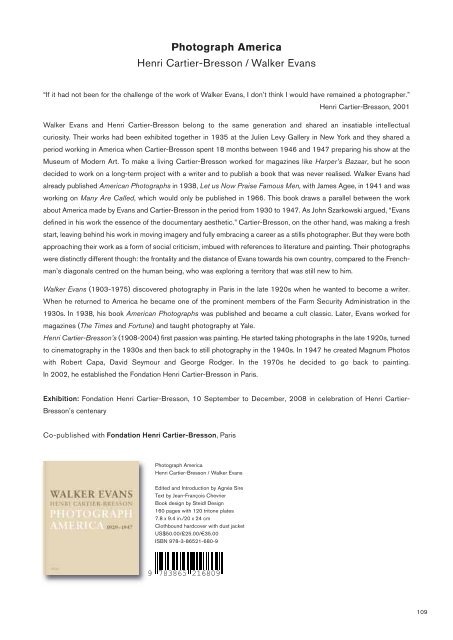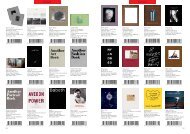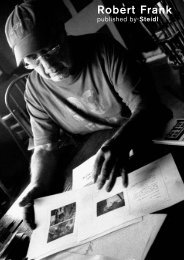The Lewis Baltz Library - Steidl
The Lewis Baltz Library - Steidl
The Lewis Baltz Library - Steidl
You also want an ePaper? Increase the reach of your titles
YUMPU automatically turns print PDFs into web optimized ePapers that Google loves.
Photograph America<br />
Henri Cartier-Bresson / Walker Evans<br />
“If it had not been for the challenge of the work of Walker Evans, I don’t think I would have remained a photographer.”<br />
Henri Cartier-Bresson, 2001<br />
Walker Evans and Henri Cartier-Bresson belong to the same generation and shared an insatiable intellectual<br />
curiosity. <strong>The</strong>ir works had been exhibited together in 1935 at the Julien Levy Gallery in New York and they shared a<br />
period working in America when Cartier-Bresson spent 18 months between 1946 and 1947 preparing his show at the<br />
Museum of Modern Art. To make a living Cartier-Bresson worked for magazines like Harper’s Bazaar, but he soon<br />
decided to work on a long-term project with a writer and to publish a book that was never realised. Walker Evans had<br />
already published American Photographs in 1938, Let us Now Praise Famous Men, with James Agee, in 1941 and was<br />
working on Many Are Called, which would only be published in 1966. This book draws a parallel between the work<br />
about America made by Evans and Cartier-Bresson in the period from 1930 to 1947. As John Szarkowski argued, “Evans<br />
defined in his work the essence of the documentary aesthetic.” Cartier-Bresson, on the other hand, was making a fresh<br />
start, leaving behind his work in moving imagery and fully embracing a career as a stills photographer. But they were both<br />
approaching their work as a form of social criticism, imbued with references to literature and painting. <strong>The</strong>ir photographs<br />
were distinctly different though: the frontality and the distance of Evans towards his own country, compared to the Frenchman’s<br />
diagonals centred on the human being, who was exploring a territory that was still new to him.<br />
Walker Evans (1903-1975) discovered photography in Paris in the late 1920s when he wanted to become a writer.<br />
When he returned to America he became one of the prominent members of the Farm Security Administration in the<br />
1930s. In 1938, his book American Photographs was published and became a cult classic. Later, Evans worked for<br />
magazines (<strong>The</strong> Times and Fortune) and taught photography at Yale.<br />
Henri Cartier-Bresson’s (1908-2004) first passion was painting. He started taking photographs in the late 1920s, turned<br />
to cinematography in the 1930s and then back to still photography in the 1940s. In 1947 he created Magnum Photos<br />
with Robert Capa, David Seymour and George Rodger. In the 1970s he decided to go back to painting.<br />
In 2002, he established the Fondation Henri Cartier-Bresson in Paris.<br />
Exhibition: Fondation Henri Cartier-Bresson, 10 September to December, 2008 in celebration of Henri Cartier-<br />
Bresson’s centenary<br />
Co-published with Fondation Henri Cartier-Bresson, Paris<br />
Photograph America<br />
Henri Cartier-Bresson / Walker Evans<br />
Edited and Introduction by Agnès Sire<br />
Text by Jean-François Chevrier<br />
Book design by <strong>Steidl</strong> Design<br />
160 pages with 120 tritone plates<br />
7.8 x 9.4 in./20 x 24 cm<br />
Clothbound hardcover with dust jacket<br />
US$50.00/£25.00/€35.00<br />
ISBN 978-3-86521-680-9<br />
109











